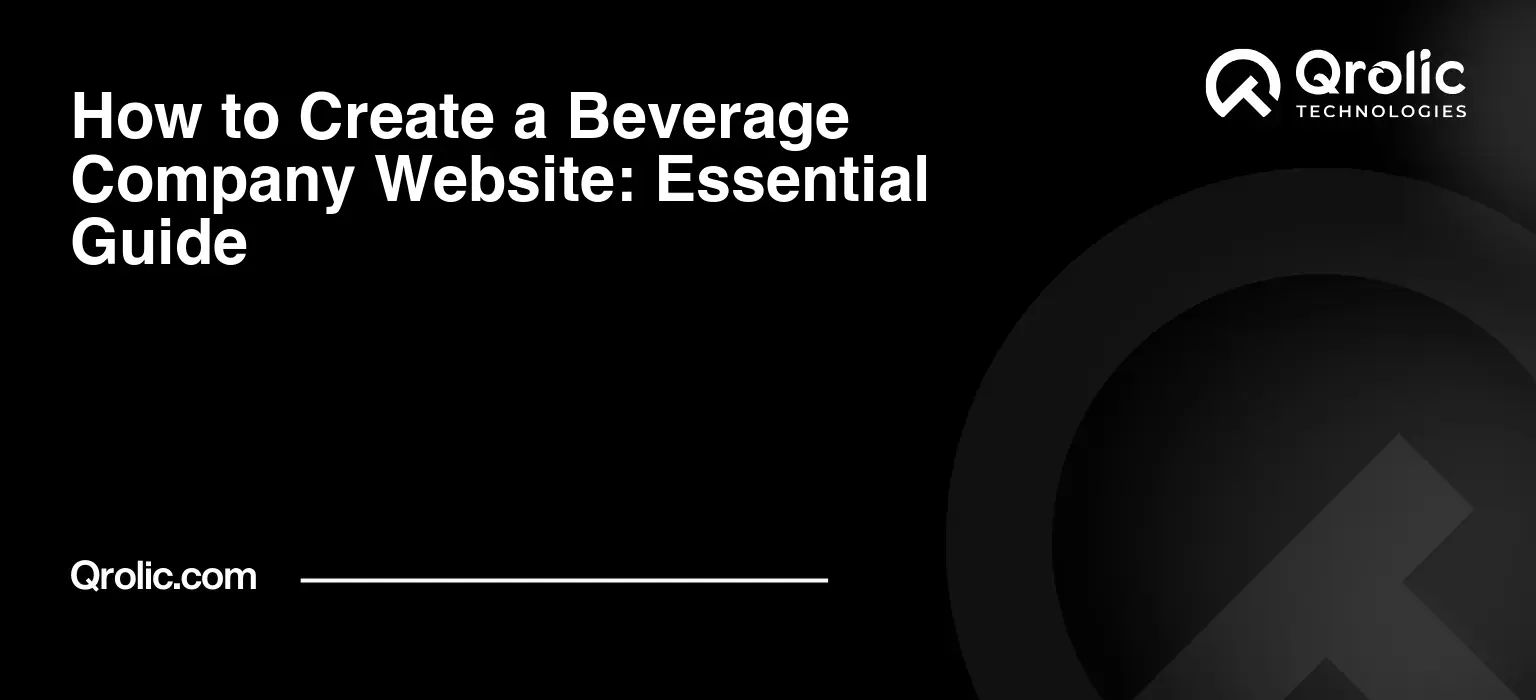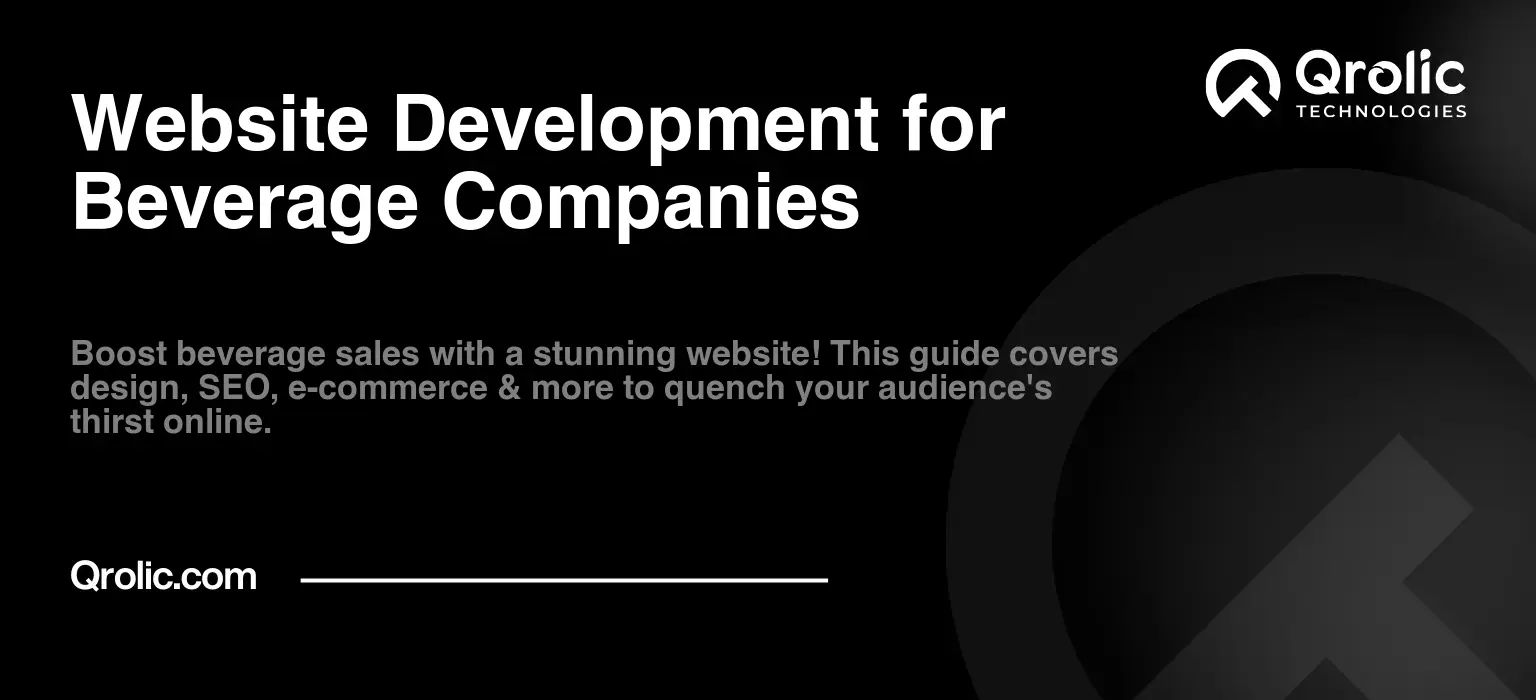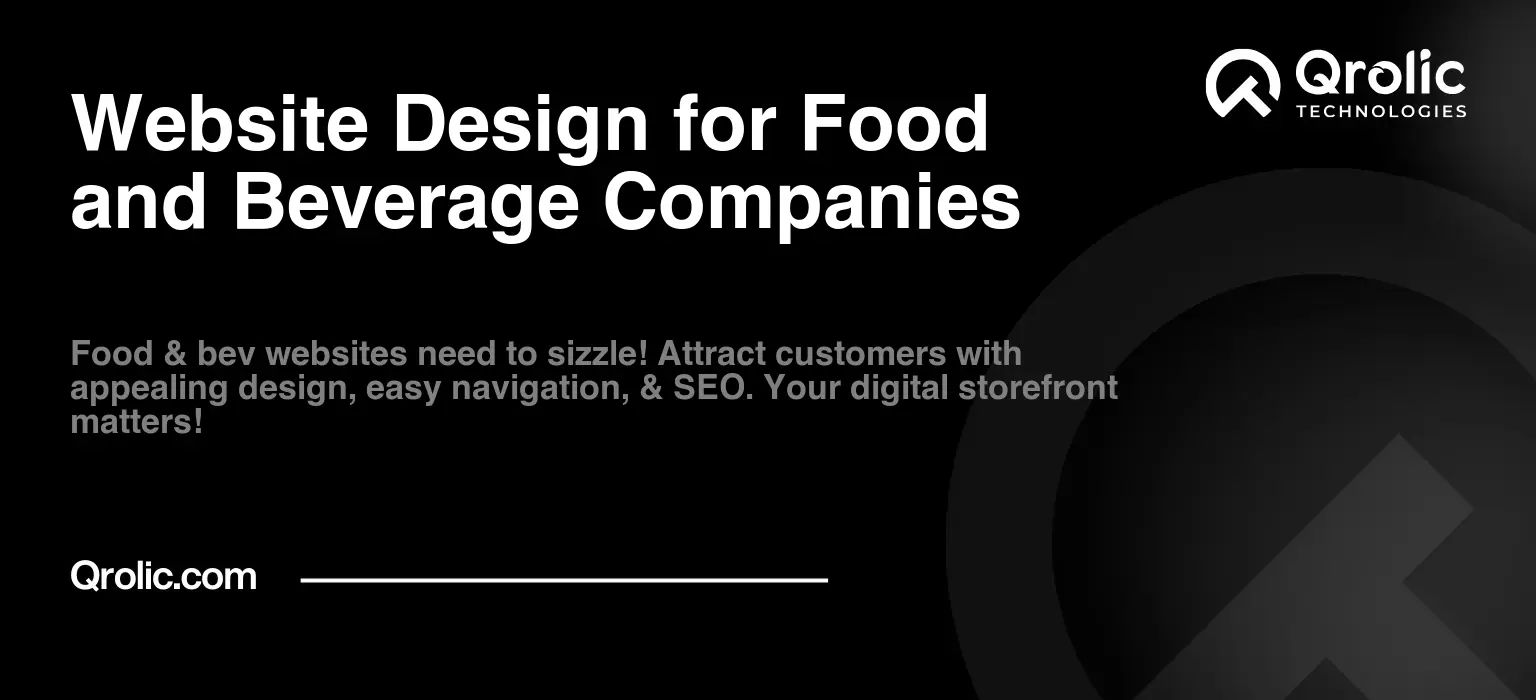Quick Summary:
- A website is vital for your beverage brand.
- Plan carefully, design well, and add great content.
- Optimize your site for search and marketing.
- Keep it updated and track its performance.
Table of Contents
- Why Your Beverage Company Needs a Stellar Website
- Phase 1: Planning and Strategy – Laying the Foundation for Success
- Defining Your Website’s Purpose and Goals
- Understanding Your Target Audience
- Analyzing Your Competitors
- Defining Your Brand Voice and Messaging
- Choosing a Domain Name and Hosting Provider
- Creating a Sitemap
- Phase 2: Design and Development – Bringing Your Vision to Life
- Choosing a Website Platform (CMS)
- Selecting a Design Template or Theme
- Creating Compelling Content
- Implementing E-Commerce Functionality (If Applicable)
- Optimizing for Mobile Devices
- Integrating Social Media
- Phase 3: SEO and Marketing – Driving Traffic and Generating Leads
- Optimizing Your Website for Search Engines (SEO)
- Implementing Content Marketing
- Using Social Media Marketing
- Running Email Marketing Campaigns
- Utilizing Paid Advertising (PPC)
- Tracking and Analyzing Your Results
- Phase 4: Maintenance and Optimization – Keeping Your Website Fresh and Effective
- Regularly Updating Your Website Content
- Performing Regular Security Audits
- Monitoring Your Website Performance
- Gathering and Responding to Customer Feedback
- Adapting to New Trends and Technologies
- Essential Pages for Your Beverage Company Website
- Qrolic Technologies: Your Partner in Digital Transformation
- Measuring Success: Key Performance Indicators (KPIs)
Why Your Beverage Company Needs a Stellar Website
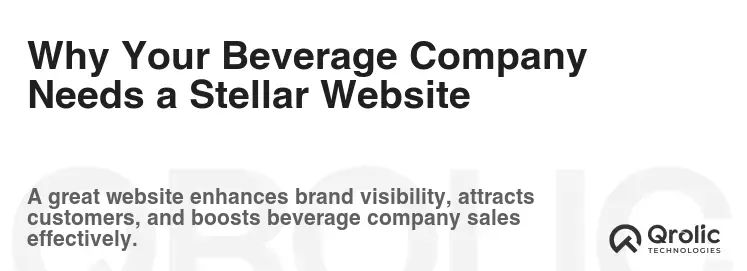
In today’s hyper-connected world, a website isn’t just an option for your beverage company; it’s a necessity. Think of it as your digital storefront, the place where potential customers get their first impression of your brand. It’s where they learn about your story, your products, and what makes you different from the competition.
- Building Brand Authority and Trust: A professional website instantly lends credibility to your beverage brand. It shows you’re serious about your business and invested in providing a positive customer experience. Think of it as your 24/7 brand ambassador, always working to build trust.
- Reaching a Wider Audience: Forget geographical limitations. With a website, you can reach customers across the street or across the globe. This opens up incredible opportunities for growth and expansion. Imagine your local craft soda being enjoyed in a different state or even country!
- Showcasing Your Unique Beverage Offerings: Use your website to highlight your unique selling points. What makes your beverages special? Is it the organic ingredients, the unique flavor combinations, or the sustainable sourcing? Let your website tell that story.
- Driving Sales and Revenue Growth: An e-commerce enabled website allows you to sell your beverages directly to consumers. This eliminates the middleman and puts you in control of the customer experience. Think about offering exclusive online deals or subscription boxes to incentivize purchases.
- Providing Customer Support and Engagement: A website can be a valuable tool for customer service. Provide FAQs, contact forms, and even live chat to address customer inquiries quickly and efficiently. Happy customers are repeat customers!
- Collecting Valuable Customer Data: Use website analytics to track customer behavior and preferences. This data can inform your marketing strategies, product development, and overall business decisions. Knowledge is power, and your website is a data goldmine.
- Boosting Your Marketing Efforts (SEO, Social Media, etc.): A well-optimized website serves as the foundation for all your marketing efforts. It improves your search engine ranking (SEO), provides content for social media, and allows you to run effective online advertising campaigns. It’s the central hub of your digital marketing strategy.
Phase 1: Planning and Strategy – Laying the Foundation for Success
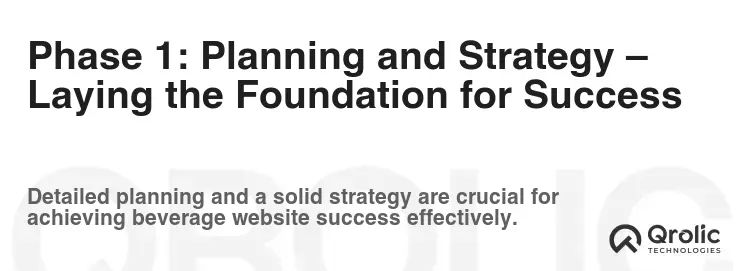
Before you even think about design or code, you need a solid plan. This phase is all about defining your goals, understanding your audience, and crafting a strategy that will set you up for success.
Defining Your Website’s Purpose and Goals
What do you want your website to achieve? Be specific and measurable. Do you want to:
- Increase brand awareness?
- Generate leads for distributors?
- Sell beverages online?
- Promote events and partnerships?
- Provide information about your company and products?
Clearly defined goals will guide every decision you make throughout the website creation process.
Understanding Your Target Audience
Who are you trying to reach with your website? Knowing your audience is crucial for creating a website that resonates with them. Consider:
- Demographics: Age, gender, location, income, education
- Psychographics: Interests, values, lifestyle, attitudes
- Buying Behavior: How do they typically purchase beverages? What motivates them?
- Pain Points: What challenges are they facing that your beverages can solve?
Create detailed buyer personas to represent your ideal customers. This will help you tailor your website’s content, design, and functionality to their specific needs and preferences.
Analyzing Your Competitors
Take a look at your competitors’ websites. What are they doing well? Where are they falling short? This analysis can provide valuable insights and help you identify opportunities to differentiate your brand.
- Identify Key Competitors: Make a list of your main competitors in the beverage industry.
- Evaluate Their Websites: Assess their design, content, functionality, and user experience.
- Identify Strengths and Weaknesses: What are they doing well? Where could they improve?
- Find Opportunities for Differentiation: How can you create a website that stands out from the crowd?
Defining Your Brand Voice and Messaging
Your website should reflect your brand’s personality and values. Define your brand voice and create consistent messaging that resonates with your target audience.
- Brand Voice: Is your brand playful, sophisticated, or down-to-earth?
- Key Messages: What are the most important things you want to communicate about your brand?
- Tone of Voice: How should you communicate with your audience? (e.g., friendly, professional, informative)
Choosing a Domain Name and Hosting Provider
Your domain name is your website’s address on the internet. Choose a domain name that is:
- Relevant: Reflects your brand or the type of beverages you sell.
- Memorable: Easy to remember and spell.
- Short: Concise and easy to type.
- Available: Check if the domain name is available before you commit.
Your hosting provider is where your website files are stored. Choose a reliable hosting provider that offers:
- Fast Loading Speeds: Essential for user experience and SEO.
- Security: Protects your website from hackers and malware.
- Scalability: Can handle increasing traffic as your business grows.
- Customer Support: Provides assistance when you need it.
Creating a Sitemap
A sitemap is a visual representation of your website’s structure. It helps you organize your content and ensure that users can easily navigate your website.
- List All Pages: Include all the pages you plan to have on your website.
- Organize Pages Logically: Group related pages together.
- Create a Navigation Structure: Define how users will navigate between pages.
Phase 2: Design and Development – Bringing Your Vision to Life
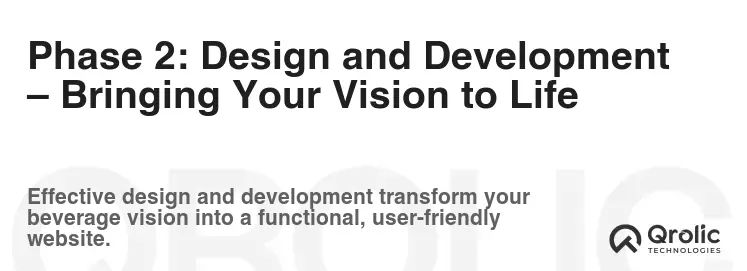
This phase is where your website starts to take shape. You’ll choose a design template, create compelling content, and implement the necessary functionality.
Choosing a Website Platform (CMS)
A content management system (CMS) makes it easy to create and manage your website content without needing to code. Popular options include:
- wordpress: The most popular CMS, known for its flexibility and extensive plugin library. Ideal for blogs, e-commerce sites, and general business websites.
- Shopify: A dedicated e-commerce platform, perfect for selling beverages online. Offers built-in features for managing products, orders, and payments.
- Wix: A user-friendly drag-and-drop website builder, suitable for small businesses with simple websites.
- Squarespace: A stylish website builder known for its elegant templates and ease of use.
Consider your technical skills, budget, and website requirements when choosing a CMS.
Selecting a Design Template or Theme
A design template or theme provides the visual structure for your website. Choose a template that:
- Is Visually Appealing: Aligns with your brand aesthetic and target audience.
- Is Mobile-Responsive: Adapts to different screen sizes (desktops, tablets, smartphones).
- Is Customizable: Allows you to modify the design to match your brand.
- Is SEO-Friendly: Optimized for search engines.
- Is Compatible with Your CMS: Works seamlessly with your chosen CMS.
Many CMS platforms offer free and premium templates. Browse the available options and choose one that best suits your needs.
Creating Compelling Content
Content is king! Your website content should be informative, engaging, and optimized for search engines.
- Homepage: Your website’s welcome mat. Clearly communicate your brand’s value proposition and guide visitors to key pages.
- About Us: Tell your brand story and connect with your audience on a personal level.
- Products: Showcase your beverages with high-quality images and detailed descriptions.
- Blog: Share valuable content related to your industry, such as recipes, brewing tips, or health benefits.
- Contact Us: Make it easy for customers to reach you with questions or feedback.
- FAQ: Answer frequently asked questions to save time and provide helpful information.
Use high-quality images and videos to enhance your content and make your website more visually appealing.
Implementing E-Commerce Functionality (If Applicable)
If you plan to sell beverages online, you’ll need to implement e-commerce functionality. This includes:
- Product Listings: Create detailed product pages with images, descriptions, and pricing.
- Shopping Cart: Allow customers to add products to their cart and proceed to checkout.
- Payment Gateway: Integrate a secure payment gateway to process online payments.
- Shipping Options: Offer various shipping options and calculate shipping costs.
- Order Management: Track orders and manage inventory.
Consider using an e-commerce platform like Shopify or WooCommerce (a WordPress plugin) to simplify the process.
Optimizing for Mobile Devices
More and more people are browsing the web on their smartphones and tablets. Make sure your website is mobile-responsive and provides a seamless user experience on all devices.
- Use a Mobile-Responsive Design Template: Ensures your website adapts to different screen sizes.
- Optimize Images for Mobile: Reduce image file sizes to improve loading speeds on mobile devices.
- Use Clear and Concise Content: Mobile users have shorter attention spans, so get straight to the point.
- Make it Easy to Navigate: Use a simple and intuitive navigation menu.
Integrating Social Media
Social media is a powerful tool for promoting your beverage brand. Integrate social media icons on your website and encourage visitors to follow you on social media.
- Display Social Media Icons: Prominently display social media icons on your website.
- Share Content on Social Media: Share your website content on social media to drive traffic and engagement.
- Embed Social Media Feeds: Embed your social media feeds on your website to showcase your social media activity.
Phase 3: SEO and Marketing – Driving Traffic and Generating Leads
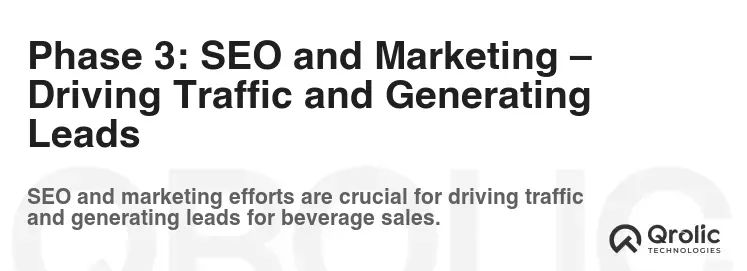
Creating a beautiful website is only half the battle. You also need to optimize it for search engines and promote it to your target audience.
Optimizing Your Website for Search Engines (SEO)
SEO is the process of optimizing your website to rank higher in search engine results pages (SERPs). This will help you attract more organic traffic from potential customers.
- Keyword Research: Identify the keywords that your target audience is using to search for beverages online. Tools like Google Keyword Planner, Ahrefs, and SEMrush can help with keyword research.
- On-Page Optimization: Optimize your website content and structure for your target keywords. This includes:
- Title Tags: Create compelling and keyword-rich title tags for each page.
- Meta Descriptions: Write concise and informative meta descriptions that entice users to click.
- Header Tags: Use header tags (H1, H2, H3, etc.) to structure your content and highlight important keywords.
- Image Alt Text: Add descriptive alt text to your images to improve accessibility and SEO.
- Internal Linking: Link to other relevant pages on your website to improve navigation and SEO.
- Off-Page Optimization: Build backlinks from other reputable websites to improve your website’s authority and ranking. This can include:
- Guest Blogging: Write guest posts for other websites in your industry and include a link back to your website.
- Directory Submissions: Submit your website to relevant online directories.
- Social Media Marketing: Share your website content on social media to generate traffic and engagement.
- Technical SEO: Ensure your website is technically sound and easy for search engines to crawl and index. This includes:
- Site Speed Optimization: Improve your website’s loading speed by optimizing images, using a content delivery network (CDN), and caching your website.
- Mobile-Friendliness: Ensure your website is mobile-responsive and provides a seamless user experience on all devices.
- Sitemap Submission: Submit your sitemap to Google Search Console to help Google crawl and index your website.
- Robots.txt File: Create a robots.txt file to tell search engine crawlers which pages to crawl and which to ignore.
- SSL Certificate: Install an SSL certificate to secure your website and protect user data.
Implementing Content Marketing
Content marketing is the process of creating and distributing valuable, relevant, and consistent content to attract and engage your target audience.
- Blog Posts: Share valuable content related to your industry, such as recipes, brewing tips, or health benefits.
- Infographics: Create visually appealing infographics that present complex information in an easy-to-understand format.
- Videos: Produce engaging videos that showcase your beverages, tell your brand story, or provide educational content.
- Ebooks: Create comprehensive ebooks that provide in-depth information on a specific topic.
- Case Studies: Share success stories of customers who have benefited from your beverages.
Promote your content on social media, email, and other channels to reach a wider audience.
Using Social Media Marketing
Social media is a powerful tool for promoting your beverage brand and engaging with your target audience.
- Choose the Right Platforms: Focus on the social media platforms that your target audience uses most often.
- Create Engaging Content: Share visually appealing content that resonates with your audience.
- Run Social Media Ads: Use social media ads to reach a wider audience and promote your beverages.
- Engage with Your Followers: Respond to comments and messages promptly and engage in conversations with your followers.
- Run Contests and Giveaways: Encourage engagement and generate excitement by running contests and giveaways.
Running Email Marketing Campaigns
Email marketing is a cost-effective way to stay in touch with your customers and promote your beverages.
- Build an Email List: Collect email addresses from website visitors, social media followers, and other sources.
- Segment Your Email List: Segment your email list based on demographics, interests, and buying behavior.
- Create Targeted Email Campaigns: Send targeted email campaigns to each segment of your email list.
- Automate Your Email Marketing: Automate your email marketing to save time and improve efficiency.
Utilizing Paid Advertising (PPC)
Paid advertising, also known as pay-per-click (PPC), is a way to drive traffic to your website by paying for ads on search engines and other websites.
- Google Ads: Use Google Ads to target potential customers who are searching for beverages online.
- Social Media Ads: Use social media ads to target potential customers based on their demographics, interests, and behavior.
- Retargeting Ads: Use retargeting ads to target website visitors who have previously shown interest in your beverages.
Tracking and Analyzing Your Results
It’s essential to track and analyze your website’s performance to see what’s working and what’s not.
- Google Analytics: Use Google Analytics to track website traffic, user behavior, and conversions.
- Social Media Analytics: Use social media analytics to track engagement, reach, and traffic from social media.
- Email Marketing Analytics: Use email marketing analytics to track open rates, click-through rates, and conversions from email campaigns.
- PPC Analytics: Use PPC analytics to track impressions, clicks, conversions, and cost per conversion from paid advertising campaigns.
Use this data to make informed decisions about your website design, content, SEO, and marketing strategies.
Phase 4: Maintenance and Optimization – Keeping Your Website Fresh and Effective
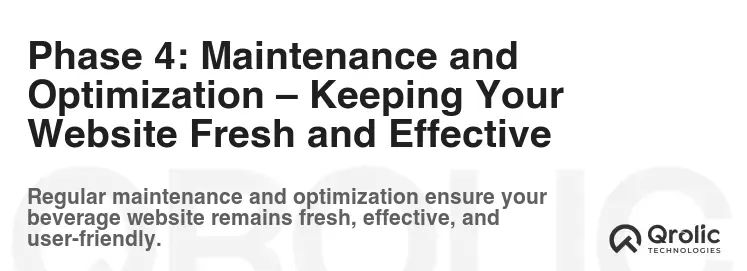
Your website is not a “set it and forget it” project. It requires ongoing maintenance and optimization to ensure it remains effective.
Regularly Updating Your Website Content
Keep your website content fresh and up-to-date by:
- Adding New Blog Posts: Share valuable content on a regular basis to attract new visitors and engage your existing audience.
- Updating Product Information: Keep your product information accurate and up-to-date.
- Adding New Products: Showcase new beverages as they become available.
- Updating Your About Us Page: Keep your brand story current and engaging.
Performing Regular Security Audits
Protect your website from hackers and malware by:
- Using Strong Passwords: Use strong, unique passwords for all your website accounts.
- Keeping Your CMS and Plugins Up-to-Date: Update your CMS and plugins regularly to patch security vulnerabilities.
- Installing a Security Plugin: Use a security plugin to scan your website for malware and other security threats.
- Backing Up Your Website Regularly: Back up your website regularly so you can restore it in case of a security breach.
Monitoring Your Website Performance
Monitor your website’s performance to ensure it’s loading quickly and providing a positive user experience.
- Check Your Website Speed: Use tools like Google PageSpeed Insights and GTmetrix to check your website’s loading speed.
- Monitor Your Website Uptime: Use a website monitoring service to track your website’s uptime and receive alerts if it goes down.
- Track Your Website Traffic: Use Google Analytics to track your website traffic and identify any issues.
Gathering and Responding to Customer Feedback
Collect customer feedback to improve your website and your overall business.
- Use Online Surveys: Use online surveys to gather feedback from website visitors.
- Monitor Social Media: Monitor social media for mentions of your brand and respond to comments and messages promptly.
- Read Online Reviews: Read online reviews to see what customers are saying about your beverages and your website.
Use this feedback to make improvements to your website and your overall business.
Adapting to New Trends and Technologies
The digital landscape is constantly evolving. Stay up-to-date on the latest trends and technologies and adapt your website accordingly.
- Mobile-First Design: Design your website for mobile devices first, then adapt it for desktops.
- Voice Search Optimization: Optimize your website for voice search by using natural language and answering common questions.
- Artificial Intelligence (AI): Use AI-powered tools to personalize the user experience and automate tasks.
By continuously maintaining and optimizing your website, you can ensure it remains a valuable asset for your beverage company.
Essential Pages for Your Beverage Company Website
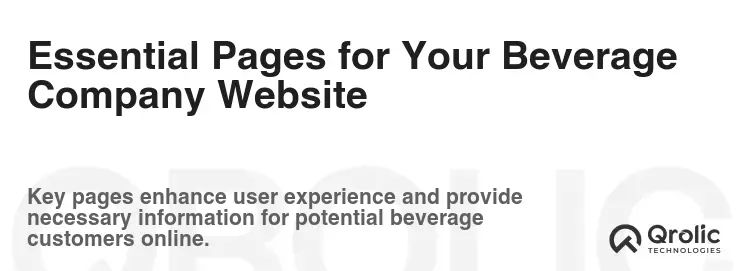
Beyond the basics, certain pages are crucial for engaging customers and driving sales.
- Product Catalog: Showcase your entire beverage lineup with high-quality images, detailed descriptions, ingredients lists, and nutritional information.
- Recipes & Pairings: Offer creative ways to enjoy your beverages. Include recipes that incorporate your drinks or suggest food pairings. This adds value and encourages experimentation.
- Sustainability & Sourcing: Highlight your commitment to sustainability and ethical sourcing practices. This resonates with increasingly conscious consumers.
- Wholesale Information: If you sell to restaurants, bars, or retailers, create a dedicated section with information for potential wholesale partners.
- Events & Promotions: Promote upcoming events, tastings, or special offers. This keeps your audience informed and engaged.
- News & Press: Share company news, press releases, and media mentions. This builds credibility and showcases your brand’s achievements.
- Distributor Locator: Help customers find where to buy your beverages locally. This is essential for driving sales through retail channels.
Qrolic Technologies: Your Partner in Digital Transformation

At Qrolic Technologies (https://qrolic.com/), we understand the unique challenges and opportunities facing beverage companies in the digital age. We offer a comprehensive range of services to help you create a website that not only looks great but also drives results.
- Website Design and Development: We create custom websites that are tailored to your specific needs and goals. Our team of experienced designers and developers will work with you to create a website that is visually appealing, user-friendly, and optimized for search engines.
- E-Commerce Solutions: We can help you implement e-commerce functionality on your website so you can sell your beverages directly to consumers. We offer a variety of e-commerce platforms, including Shopify and WooCommerce, and we can customize these platforms to meet your specific requirements.
- SEO and Digital Marketing: We offer a full range of SEO and digital marketing services to help you attract more traffic to your website and generate leads. Our team of experienced marketers will work with you to develop a comprehensive marketing strategy that is tailored to your specific goals.
- Content Creation: We can help you create compelling content for your website, including blog posts, articles, infographics, and videos. Our team of experienced writers and designers will work with you to create content that is informative, engaging, and optimized for search engines.
- Website Maintenance and Support: We offer ongoing website maintenance and support to ensure your website is always running smoothly and securely. Our team of experienced technicians will be available to answer your questions and resolve any issues you may encounter.
We are committed to helping beverage companies like yours succeed in the digital age. Contact us today to learn more about our services and how we can help you create a website that drives results. Let Qrolic Technologies be your partner in navigating the complexities of the digital world and achieving your business objectives. We understand food industry design and beverage website creation like no other.
Measuring Success: Key Performance Indicators (KPIs)
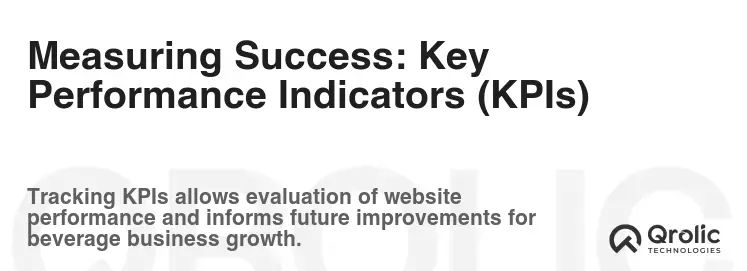
How will you know if your website is achieving its goals? Track these KPIs:
- Website Traffic: Monitor the number of visitors to your website.
- Bounce Rate: The percentage of visitors who leave your website after viewing only one page. A lower bounce rate indicates that your website is engaging visitors.
- Conversion Rate: The percentage of visitors who complete a desired action, such as making a purchase or filling out a contact form.
- Average Order Value: The average amount of money spent per order.
- Customer Lifetime Value: The total revenue you expect to generate from a single customer over their lifetime.
- Social Media Engagement: Track likes, shares, comments, and followers on social media.
- Email Open and Click-Through Rates: Measure the effectiveness of your email marketing campaigns.
Regularly analyze these KPIs to identify areas for improvement and optimize your website for better results.
